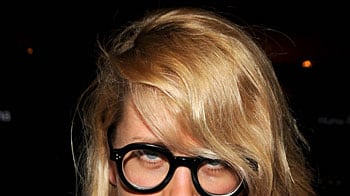
Aurel Schmidt still hasn’t recovered from the brutal text message she received from 2010 Whitney Biennial co-curator Francesco Bonami after submitting her finished work. Schmidt, one of 55 artists selected for the exhibition (which runs through May 30), had just sent a JPEG of her contribution: a seven-foot-tall drawing of a sexy Minotaur with bulging muscles, star-speckled black skin, a mane of delicate blue flowers, and a six-pack of beer cans for abs.
“The piece is shit and I don’t appreciate the Jeff Koons reference,” Bonami wrote her. He was referring to the little brown and yellow bird perched on the man-beast’s right bicep—an image borrowed from Koons’ 1988 sculpture, Stacked.
“I felt like I got punched in the stomach!” Schmidt says. “I wrote back, ‘Are you serious?!’ I thought ‘I’m going to die! I’m going to barf!’”
His response: “Just kidding. It’s great.”
“I was like, ‘You bastard! If I were elderly I would have died of a heart attack! That was horrible!’” Schmidt says, laughing, but still a touch shaken—the Biennial is, after all, her biggest professional coup to date. “He knows he can joke around with me, though—he knows I have a sense of humor, he knows I’m not into that sort of formality. I mean, it’s 2010. Let’s text, let’s email, let’s not do this formal ‘Best Regards’ thing…”
Click Image to View Our Gallery of Aurel Schmidt’s Art

The 27-year-old Schmidt doesn’t like to play by the rules (and if this means the occasional gut-wrenching practical joke, she’ll take it). She embraces sex and grit, drawing dirty tampons, condom-wrapped vegetables, and fleshy erect penises sprouting out of the ground like flowers; she didn’t go to art school; she sticks firmly to her colored-pencil-and-acrylic-on-paper medium (adding texture, at times, with splashes of beer, dirt, drops of her own blood, and the occasional cigarette burn); and she doesn’t have formal representation through a gallery—nor does she particularly want it. Indeed, Schmidt’s astonishing ascent from New York nobody to Whitney Biennial artist is one that’s been forged largely on her own.
Schmidt sums up her history as follows: “I was a kid who liked to draw, then I was a teenager who liked to draw, now I’m an adult who likes to draw.” And though she may look the wild downtown part (Chloë Sevigny with Clark Kent’s glasses), she is diligent and exacting in her work. Her skill manifests itself in poetic portraits of women with maggots, mice, and cigarette butts for flesh; Cheshire-like smiley faces are sullied as well with rolled-up dollar bills for nostrils and doughnuts, roaches, and vaginas for eyes. But Schmidt wasn’t always quite so dark.
She was born and raised in rural British Columbia and moved to Vancouver shortly after high school. She worked the door at a bar there and drew in her spare time (portraits of dogs, mainly, and quirky outer-space scenarios). She showed her work at a local skate shop but not much beyond that. The gallery system is different in Canada—there’s no money, she says, and selection processes are long and formal. She soon met fellow artist Tim Barber and he posted her work on his artist portfolio site, Tiny Vices (where Schmidt still keeps an online archive of her drawings today). Barber eventually relocated to New York and though they weren’t close, Schmidt followed in 2005.
It wasn’t an easy move. Schmidt had to work a handful of odd jobs to just make rent (door girl, shop girl, house painter, and artist’s assistant among them); she was depressed; she didn’t fit in; people didn’t trust her and she didn’t make friends quickly or easily. “My body went into some kind of weird shock,” she says. “I felt like I was drowning in a swamp. But it was a really creative time for me.”
These feelings of isolation, fear, discomfort, and paranoia all made their way into her work. It became dark and foreboding (though always impeccable in execution) with images of flies, maggots, rotting, and decay. She was spending a lot of time at the Met, too. The place positively floored her—she had never seen a museum of its caliber, nor had she never seen masterpieces up close. And though Schmidt’s work is often noted for its similarities to that of Arcimboldo, the Italian Mannerist painter who composed human portraits out of produce and plants, she was initially drawn to Dutch still-life painters (whose handling of skulls and everyday objects ultimately served as the basis for Schmidt’s self-imposed art education).
“I was into that kind of zombie thing—the living dead,” Schmidt says. “I was hanging out with art kids who were doing heroin, not having any friends, feeling alienated and alone… It was all pretty depressing.”
“I think that whole downtown thing is kind of over,” she adds. “I think the media tried to make Dash [Snow] and Dan [Colen] into a scene—anyone with drugs and tattoos, really. But I never wanted to be part of that. I didn’t want to be part of any scene that already existed. I wanted to be a part of something new. I’m pretty nerdy and positive and there a lot of things I want out of life.”
For Schmidt, things changed in 2006. She started making headway with the New York art kids and gallery girls who hated her so much when she arrived. And that spring, Barber organized a Tiny Vices group show at the Spencer Brownstone Gallery in Soho. Schmidt’s work started selling (even to famed collector Dakis Joannou), the gallerist Javier Peres gave her an exhibition in L.A., and by 2008, she had landed a solo show at Deitch.
“The show at Peres was the first time I’d ever seen my work framed,” Schmidt says. “Since that show I haven’t worked in a job. I’ve been an artist—I literally went from being dead broke to working all the time. It was all kind of fast and stressful and crazy. I was scared. It’s weird when you’re young and you don’t have a lot of experience and you get these great opportunities. You’re like, ‘Oh… am I going to blow this??’”
She had similar fears when 2010 Biennial curators Bonami and Gary Carrion-Murayari came calling last year. Bonami knew and liked her work and Carrion-Murayari concurred. She was in.
This year, Whitney Biennial artists are each allowed only one work—good news for Schmidt, whose larger drawings can take months to complete. The piece, titled Master of the Universe / Flexmaster 3000, is somewhat of a departure from her previous work. A lot of the imagery is the same (cigarette butts, insects, bare penises, the detritus of everyday life), but her handling of it seems different. Gone is the visual stench of decay, the angst, and that young and the reckless sort of vibe. This is a loving portrait (albeit more warts-and-all than saccharine and sentimental). It’s also a touch reactionary, dispelling widespread misconceptions of Schmidt as some kind of man-hater.
“I was coming across a little feminist-y,” she says. Her last show (at Deitch) and first monograph were titled Maneater and many of the drawings included were layered with this bold and ostensibly self-sufficient approach to sexuality. Schmidt, it seems, was hinting at figures like Lynda Benglis with her double dildos and even Louise Bourgeois with her bronze oversize “ fillettes”; she was reclaiming de Kooning’s grotesque ladies for our side of the species, showing that they too are sexual creatures with wants, needs, and fetishes. Don’t Want to Be Alone Tonight (2008), a drawing of two beer cans spilling over a two-headed dildo (which forms a smiley face), and Like a Fish Needs a Bicycle (2008), a portrait of a malformed woman with a cigarette in hand and a white thong wrapped around her amphibian-like ankles.
“For the Biennial, I was definitely just trying to make a portrait of a man and I’ve never really worked with that,” Schmidt says. “I draw dicks a lot but it’s more of the feminine kind of wanting it or thinking about it. Here, there’s nothing attacking the penis, it’s a beautiful penis and he’s a beautiful man. I think he turned out handsome, which is what I was really hoping for. I didn’t want him to be scary or ugly. I wanted to aim toward something loving—and loving isn’t easy. It’s dirty, it’s hard, it’s crazy.”
Plus: Check out Art Beast, for galleries, interviews with artists, and photos from the hottest parties.
Rachel Wolff is a New York-based writer and editor who has covered art for New York, ARTnews, and Manhattan.






